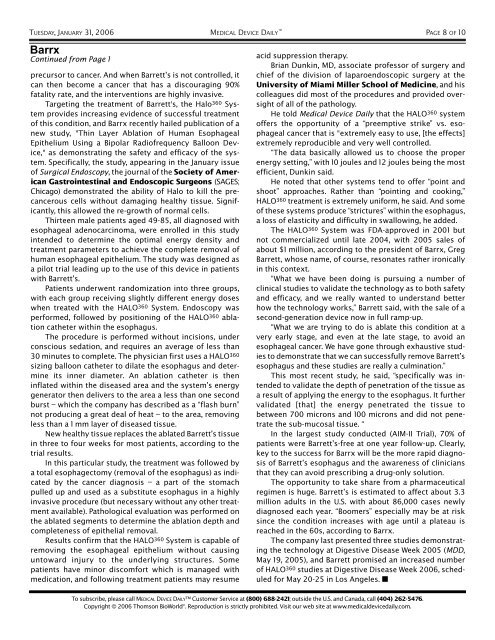INSIDE: - Medical Device Daily
INSIDE: - Medical Device Daily
INSIDE: - Medical Device Daily
Create successful ePaper yourself
Turn your PDF publications into a flip-book with our unique Google optimized e-Paper software.
TUESDAY, JANUARY 31, 2006 MEDICAL DEVICE DAILY PAGE 8 OF 10BarrxContinued from Page 1precursor to cancer. And when Barrett’s is not controlled, itcan then become a cancer that has a discouraging 90%fatality rate, and the interventions are highly invasive.Targeting the treatment of Barrett's, the Halo 360 Systemprovides increasing evidence of successful treatmentof this condition, and Barrx recently hailed publication of anew study, "Thin Layer Ablation of Human EsophagealEpithelium Using a Bipolar Radiofrequency Balloon <strong>Device</strong>,"as demonstrating the safety and efficacy of the system.Specifically, the study, appearing in the January issueof Surgical Endoscopy, the journal of the Society of AmericanGastrointestinal and Endoscopic Surgeons (SAGES;Chicago) demonstrated the ability of Halo to kill the precancerouscells without damaging healthy tissue. Significantly,this allowed the re-growth of normal cells.Thirteen male patients aged 49-85, all diagnosed withesophageal adenocarcinoma, were enrolled in this studyintended to determine the optimal energy density andtreatment parameters to achieve the complete removal ofhuman esophageal epithelium. The study was designed asa pilot trial leading up to the use of this device in patientswith Barrett’s.Patients underwent randomization into three groups,with each group receiving slightly different energy doseswhen treated with the HALO 360 System. Endoscopy wasperformed, followed by positioning of the HALO 360 ablationcatheter within the esophagus.The procedure is performed without incisions, underconscious sedation, and requires an average of less than30 minutes to complete. The physician first uses a HALO 360sizing balloon catheter to dilate the esophagus and determineits inner diameter. An ablation catheter is theninflated within the diseased area and the system’s energygenerator then delivers to the area a less than one secondburst – which the company has described as a “flash burn”not producing a great deal of heat – to the area, removingless than a 1 mm layer of diseased tissue.New healthy tissue replaces the ablated Barrett’s tissuein three to four weeks for most patients, according to thetrial results.In this particular study, the treatment was followed bya total esophagectomy (removal of the esophagus) as indicatedby the cancer diagnosis – a part of the stomachpulled up and used as a substitute esophagus in a highlyinvasive procedure (but necessary without any other treatmentavailable). Pathological evaluation was performed onthe ablated segments to determine the ablation depth andcompleteness of epithelial removal.Results confirm that the HALO 360 System is capable ofremoving the esophageal epithelium without causinguntoward injury to the underlying structures. Somepatients have minor discomfort which is managed withmedication, and following treatment patients may resumeacid suppression therapy.Brian Dunkin, MD, associate professor of surgery andchief of the division of laparoendoscopic surgery at theUniversity of Miami Miller School of Medicine, and hiscolleagues did most of the procedures and provided oversightof all of the pathology.He told <strong>Medical</strong> <strong>Device</strong> <strong>Daily</strong> that the HALO 360 systemoffers the opportunity of a “preemptive strike” vs. esophagealcancer that is "extremely easy to use, [the effects]extremely reproducible and very well controlled.“The data basically allowed us to choose the properenergy setting,” with 10 joules and 12 joules being the mostefficient, Dunkin said.He noted that other systems tend to offer “point andshoot” approaches. Rather than “pointing and cooking,”HALO 360 treatment is extremely uniform, he said. And someof these systems produce “strictures” within the esophagus,a loss of elasticity and difficulty in swallowing, he added.The HALO 360 System was FDA-approved in 2001 butnot commercialized until late 2004, with 2005 sales ofabout $1 million, according to the president of Barrx, GregBarrett, whose name, of course, resonates rather ironicallyin this context.“What we have been doing is pursuing a number ofclinical studies to validate the technology as to both safetyand efficacy, and we really wanted to understand betterhow the technology works,” Barrett said, with the sale of asecond-generation device now in full ramp-up.“What we are trying to do is ablate this condition at avery early stage, and even at the late stage, to avoid anesophageal cancer. We have gone through exhaustive studiesto demonstrate that we can successfully remove Barrett’sesophagus and these studies are really a culmination.”This most recent study, he said, “specifically was intendedto validate the depth of penetration of the tissue asa result of applying the energy to the esophagus. It furthervalidated [that] the energy penetrated the tissue tobetween 700 microns and 100 microns and did not penetratethe sub-mucosal tissue. “In the largest study conducted (AIM-II Trial), 70% ofpatients were Barrett’s-free at one year follow-up. Clearly,key to the success for Barrx will be the more rapid diagnosisof Barrett’s esophagus and the awareness of cliniciansthat they can avoid prescribing a drug-only solution.The opportunity to take share from a pharmaceuticalregimen is huge. Barrett’s is estimated to affect about 3.3million adults in the U.S. with about 86,000 cases newlydiagnosed each year. “Boomers” especially may be at risksince the condition increases with age until a plateau isreached in the 60s, according to Barrx.The company last presented three studies demonstratingthe technology at Digestive Disease Week 2005 (MDD,May 19, 2005), and Barrett promised an increased numberof HALO 360 studies at Digestive Disease Week 2006, scheduledfor May 20-25 in Los Angeles. ■To subscribe, please call MEDICAL DEVICE DAILY Customer Service at (800) 688-2421; outside the U.S. and Canada, call (404) 262-5476.Copyright © 2006 Thomson BioWorld ® . Reproduction is strictly prohibited. Visit our web site at www.medicaldevicedaily.com.
















